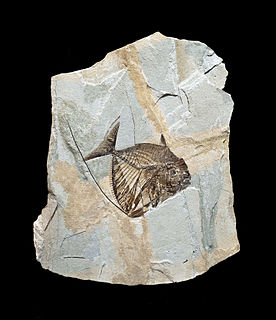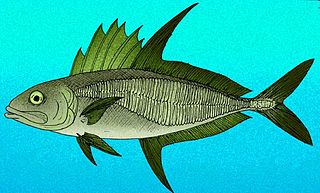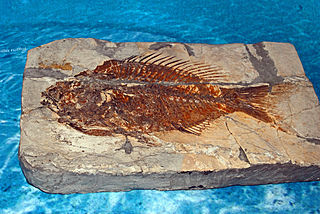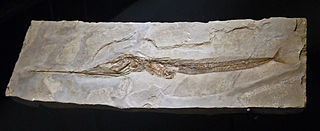
Monte Bolca is a lagerstätte near Verona, Italy that was one of the first fossil sites with high quality preservation known to Europeans, and is still an important source of fossils from the Eocene.

Mene rhombea is an extinct perciform fish belonging to the family Menidae. During the Middle Eocene, about 48 to 40 mya, these fishes lived in the Tethys Ocean, a large tropical sea in the area corresponding to the current Mediterranean. This ocean was extended between the continents of Gondwana and Laurasia. At this time, where Monte Bolca is today, M. rhombea, and its relative, M. oblonga, lived in a tropical lagoon.

The moonfish of the genus Mene, the sole extant genus of the family Menidae, are disk-shaped fish which bear a vague resemblance to gourami, thanks to their thread-like pelvic fins. Today, the genus is represented only by Mene maculata of the Indo-Pacific, where it is a popular food fish, especially in the Philippines, where it is known as bilong-bilong, chabita, hiwas or tahas.

Bolca is a village in the Veneto, on the southern margin of the Italian Alps. It is a frazione of the comune of Vestenanova, in the province of Verona. The area is famous for the marine fossils from the lagerstätte of Monte Bolca. It was one of the first fossil sites with high quality preservation known to Europeans, and is still an important source of fossils from the Eocene.

Amphistium paradoxum, the only species classified under the genus Amphistium, is a fossil fish which has been identified as a Paleogene relative of the flatfish, and as a transitional fossil. In a typical modern flatfish, the head is asymmetric with both eyes on one side of the head. In Amphistium, the transition from the typical symmetric head of a vertebrate is incomplete, with one eye placed near the top of the head.

Euzaphlegidae is a family of extinct escolar-like fish closely related to the snake mackerels. Fossils of euzaphlegids are found from Paleocene to Late Miocene-aged marine strata of Europe, the Caucasus Mountains, India, Iran, Turkmenistan, Italy, and Southern California.

Ceratoichthys pinnatiformis is an extinct species of lookdown-like prehistoric jackfish that lived during the Lutetian epoch, of the Middle Eocene of Monte Bolca, Italy.
Palaeopomacentrus orphae is an extinct species of fish from the Ypresian epoch of Monte Bolca. It is the only known species of the genus Palaeopomacentrus.

Eotetraodon is an extinct genus of prehistoric puffer fish that lived during the Lutetian epoch of middle Eocene. Fossil specimens are from the Monte Bolca lagerstatten, and the Kuma Horizon of the Gorny Luch locality, from the North Caucasus.

Spinacanthus cuneiformis is an extinct prehistoric tetraodontid bony fish that lived from the Lutetian epoch of Eocene Monte Bolca.

Bolcyrus is an extinct genus of prehistoric bony fish that lived from the early to middle Eocene.

Eastmanalepes primaevus is an extinct species of prehistoric jack fish that lived from the Lutetian epoch, of what is now Monte Bolca, Italy. It was originally described as a species of the jackfish genus Caranx, of which it has a superficially similar outline to. It differs from Caranx, and almost all other jackfish, in that it has very large, very pronounced scutes along its lateral line. According to Bannikov, E. primaevus is probably more related to the extinct jackfish genera, Eothynnus and Teratichthys.

Eolactoria sorbinii is an extinct prehistoric boxfish that lived during the Lutetian epoch of the middle Eocene, in Monte Bolca. It had two pairs of long spines, one over each eye, and one pair beneath the anal and caudal fins, arranged very similarly to those possessed by the modern genus Lactoria, but were, in comparison, much longer. E. sorbinii had a fifth spine between the two eye-spines, arranged and looking very much like a nose.

Sparnodus is an extinct genus of prehistoric perciform fish in the family Sparidae. Species of this genus were nektonic carnivore. These fishes lived in the Cenozoic Era, in Oligocene and Paleocene.

Protobalistum imperiale is an extinct prehistoric tetraodontid bony fish that lived from the Lutetian epoch of Eocene Monte Bolca.
Sharfia mirabilis is an extinct species of anglerfish in the family Lophiidae. It was discovered in 2011 during a review of fossil material at the Muséum national d'histoire naturelle in Paris. The fossil material was collected from the Monte Bolca Lagerstätte, one of the earliest known Eocene fossil sites. The undescribed genus was originally identified as Lophius brachysomus.

Spinacanthidae is an extinct prehistoric family of tetraodontid bony fish that lived from the Lutetian epoch of Eocene Monte Bolca.

Pristigenys is an extinct genus of fish in the family Priacanthidae. Fossils of the only species, P. substriata, have been found in the Eocene of Mount Bolca, Italy. The closely related extant genus Pseudopriacanthus was previously synonymized with Pristigenys, but has been recently revalidated based on numerous differences in the cranial region and the fins.

Blochius longirostris is a species of prehistoric fish belonging to the family Blochiidae. This fish lived in the middle Eocene and its fossils have been found exclusively in the well-known Monte Bolca (Italy).
Giovanni Serafino Volta (1764–1842) was an Italian priest, naturalist, and palaeontologist, best known for his studies of fossil fish from Monte Bolca.















